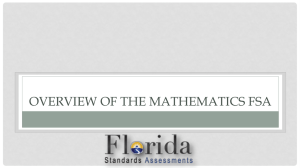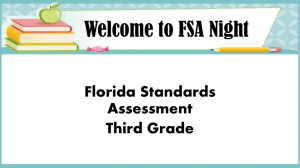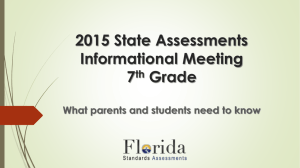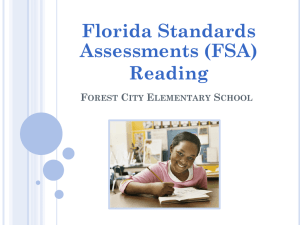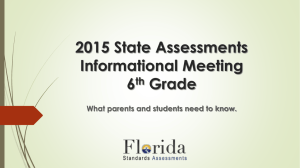MAFS and the FSA Post-FAM Secondary Presentation 01/15
advertisement
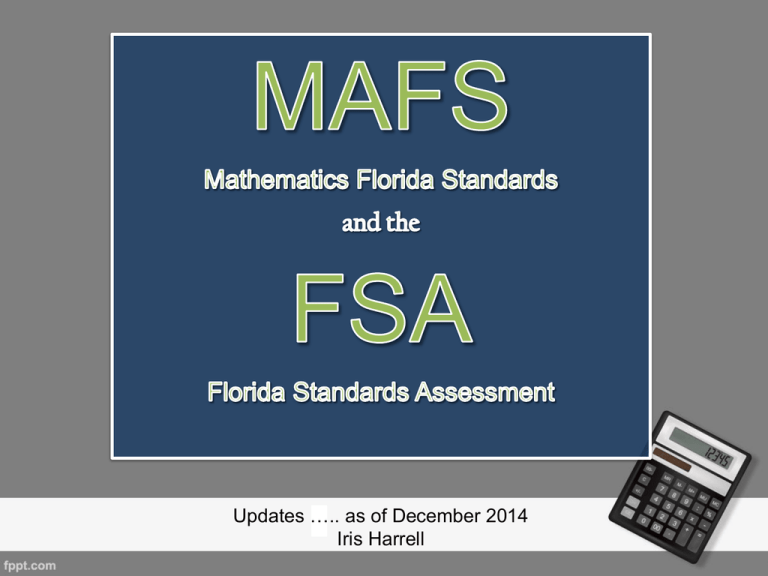
Updates ….. as of December 2014 Iris Harrell GOALS FOR TODAY… Discuss the most current information about the Florida Standards Assessments (FSA) for Mathematics. Show examples and expectations of the item types that will be on the CBT for FSA. Share teacher online resources to assist with student instruction and teacher implementation of the MAFS. Dates April - May 2015 Revised 11/24/14 End-of-Course FSA Assessments All sessions are administered over two days. NOTES: There are multiple forms of the assessment, with a maximum of 68 items on each test form. Approx. 6-10 items on all of the tests listed above are experimental (field test) items and are included in the ranges, but are not included in a student’s score. The FSA Test Item Specifications help to guide the development of scenarios and items BUT DO NOT tell what to teach. Item Specifications ARE NOT course descriptions. Draft specifications for grades 3-8, Alg. 1 and 2, and Geometry are all posted on the FSA portal at http://fsassessments.org. • Algebra 1 EOC • Geometry EOC • Algebra 2 EOC • Also assesses refers to standard(s) closely related to the primary standard statement. • Clarification statements explain what students are expected to do when responding to the question. • Assessment limits define the range of content knowledge and degree of difficulty that should be assessed in the assessment items for the standard. • Acceptable response mechanisms describe the characteristics from which a student must answer a question. • Context defines types of stimulus materials that can be used in the assessment items. Item Specifications Definitions EOC Calculator Policy Link here for DRAFT document for “Calculator and Reference Sheet Policies”. Pg. 1 lists the functions that students WILL need on FSA. Pg. 2 lists the PROHIBITED functionalities. All STUDENTS taking an FSA Mathematics Assessment (Grades 7 and 8, Algebra I, Geometry, and Algebra 2) will have access to the online calculator during the associated session(s) of their FSA, but students will also be permitted the use of an approved handheld scientific calculator. It is a school district’s decision whether or not to purchase hand-held scientific calculators for students. No items in the current FSA EOC assessments require the graphing tool in order to solve them. Therefore, a scientific calculator is sufficient for all items. Not every test item in the calculator section will require the use of a calculator. A handheld four-function calculator is NOT RECOMMENDED as a handheld because it may not be sufficient for all assessment items. http://demo.tds.airast.org/TDSCalculator/TDSCalculator.html?mode=Scientific Calculator Designations As Noted in the Test Item Specifications YES – a calculator will be available for items written to a standard. NO – a calculator will NOT be available for items written to a standard. NEUTRAL – assessment items in standards that are labeled as “neutral” are reviewed by a committee of educators to determine if the item requires the use of a calculator. If the educators feel the item DOES NOT require the use of calculator, the item MAY BE PLACED on EITHER Session. Hyperlink to DRAFT document. Formulas Presented NOTE: The full intent of the standard(s) and the notations. http://www.fsassessments.org Link to document above. See pgs. 11-12 for description of each TEI. FSA Training Tests and Resources Take the FSA EOC Training Test User Guide to the FSA Training Test Answer Key FSA EOC Mathematics Geometry Conversions AND formulas given. No formulas Algebra given II on reference sheet. Conversions AND formulas given Multiple-Choice Items Multi-Select Items Require the student to select a single answer option. Allow the student to select more than one answer option. These Multi-Select Items areare different from multiple-choice items. worth one point. Some items may ask the student to select Multi-Select DOof a specificItems number NOT have credit. responses, while partial other items may ask the student to select ALL correct A student MUST responses. SELECT ALL Multi-select items consist of: CORRECT ANSWERS A context (mathematical or to receive credit for the real-world) item. A question Two or more correct answers Several plausible distractors Multiple-choice items consist of: a context (mathematical or real-world) a question a single correct answer three plausible distractors Equation Response/Equation Editor Items Equation items require the student to enter a valid statement that answers the question. The response MAY BE a number, an expression, or an equation. Equation Response Items consist of: a context (mathematical or real-world) a question a response area Equivalent fractions and decimals WILL BE ACCEPTED except in items that are assessing a standard where a certain form is the expectation of the standard. A zero in the ones place for answers that fall between -1 and 1 (excluding 0 itself) is NOT required. Students can type in an answer using a mixed number OR a fraction greater than one. Graphic Response Item Display (GRID) Formerly referred to as: “Grid Items with Action Buttons” Grid items require the student to use the point, line, and/or arrow buttons to create a response on a grid. Grid items consist of: • • • a context (mathematical or real-world) a question a response area Hot Text Items Hot text items require the student to either click on a response option or drag a response option to another location. Hot text items consist of: a context (mathematical or real-world) a question a response area Open-Response Items Formerly identified as Natural Language Open-response items require the student to use the keyboard to enter a response into a text field. Different types of open-response items MAY appear on the test. Open-Response items consist of: a context (mathematical or real-world) a question a response area New Item Types Matching Items Matching items require the student to CHECK A BOX to indicate if information from a column header matches information from a row. Table Items Matching items consist of: a context (mathematical or real-world) Table items require the student to type NUMERIC VALUES into a given table. The student may complete the entire table or portions of the table, depending on the question that is asked. Table items consist of: a context (mathematical or real-world) a question a question a response area a response area Editing Task / Editing Choice Items New item types Editing task items require the student to CLICK on a highlighted word or phrase and ENTER a replacement word or phrase OR CLICK on a highlighted word or phrase and SELECT a replacement FROM A MENU. Editing Task items consist of: • a context (mathematical or real-world) • a question • a response area Items COULD COMBINE more than one item type. Equation Response Item Grid Item with Action Buttons This would be an example of a 2 point item. http://www.fldoe.org/core/fileparse.php/5423/urlt/FSAEOCFS2014-15.pdf FSA Scoring and Reporting www.flstandards.org Teacher Resources http://www.flstandards.org/sites/www/Uploads/G912_Mathematics_Florida_Standards.pdf http://www.flstandards.org/sites/www/Uploads/G912_Mathematics_Florida_Standards.pdf http://www.flstandards.org/sites/www/Uploads/G9-12_Calculus_Florida_Standards.pdf Content Complexity of MAFS What are the cognitive demands that can be inferred from the language of the standard? Each session of EOC would have approx. 23 items at a DOK Level 2 TOTAL Items between 2 sessions Content Complexity Overview Content complexity relates to the cognitive demands inferred from the language of a content standard. Content complexity considers factors such as: prior knowledge, processing of concepts and skills, structure/sophistication, number of parts, and application of content structure required to meet an expectation or to attain an outcome. Depth of Knowledge Originally created by Norman Webb (1997), can best be described as a tool used to measure and align the cognitive demand of instructional objectives and standardized assessment items. Webb first introduced it for the purpose of aligning assessment to standards in the area of cognitive rigor. Levels of DOK represent a hierarchy based on cognitive complexity (rather than time on task difficulty). This hierarchy is based on two main factors: 1) sophistication and complexity, and 2) the likelihood that students at the grade level tested would have received prior instruction or would have had an opportunity to learn the content. DOK Level Comparison DOK 1 DOK 2 DOK 3 FSA Practice Materials? SUGGESTIONS ONLY http://sbac.portal.airast.org/wp-content/uploads/2014/10/G11Practice-Test-Scoring-Guide-10-06-14-Final1.pdf High School has 29 practice items. Items are noted with the conceptual category, DOK level, and code for Common Core standard. Rubric for scoring would NOT represent the FSA. http://www.parcconline.org/practice-tests http://parcc.pearson.com/practice-tests/math/ Practice Test Student Booklets and Answer Keys (Not to be printed or distributed) can be used as a reference for teachers in order to discuss with students, especially the items that are representing “multi-select” types. Algebra I Alg. I KEY Geometry Geometry KEY Algebra II Algebra II KEY NOTE: This information is NOT necessarily representative of the FSA. The documents can give teachers ideas about offering students various experiences with conceptual learning in order to develop depth of content knowledge. In Grade 6, students build on the knowledge and experiences in data analysis developed in earlier grades. In Grade 7, students move from concentrating on analysis of data to production of data, understanding that good answers to statistical questions depend upon a good plan for collecting data relevant to the questions of interest. Until Grade 8, almost all of students’ statistical topics and investigations have dealt with univariate data, e.g., collections of counts or measurements of one characteristic. Eighth graders apply their experience with the coordinate plane and linear functions in the study of association between two variables related to a question of interest. Students build on knowledge and experience described in the 6-8 Statistics and Probability Progression. Students develop a more formal and precise understanding of statistical inference, which requires a deeper understanding of probability. Because of its strong connection with modeling, the domain of Statistics and Probability is starred, indicating that all of its standards are modeling standards. Learning Progression Documents http://commoncoretools.me/category/progressions/ Take a look at Tiffany’s lesson… After learning to write the equation of an ellipse, students design an elliptical pool table that would guarantee that even the worst player can always make a shot. The Master Teacher Project (MTP) is a revolutionary effort to highlight and share the best teaching practices around the Common Core. The project brings together 130+ Master Teachers in grades K-12 math and ELA to provide accessible and classroom-ready lessons that are free. “The MTP has the potential to drastically improve math instruction for students across the country by unifying great teachers and resources.” http://betterlesson.com/common_core?from=bl_header Develop Common Assessments and Submit to Algebra Nation Mini Assessment – after a section video Summative Assessment– after a unit These can be available for ALL TEACHERS in the Teacher Area Research-designed 42 specific algebra concepts Tested in over 300 classrooms with 6,000 students. Results with students who typically struggled with algebra showed significant increase in conceptual understanding of concepts. Helps Students: identify, discuss, and reduce misconceptions gain deeper conceptual understanding strengthen procedural skills Provides Teachers: insight into students’ thinking launch-point for mathematically-rich discussions with students opportunities to address misconceptions and repeated errors STRATEGIC EDUCATION RESEARCH PARTNERSHIP http://math.serpmedia.org/ http://www.okaloosaschools.com/content/curriculum-guides-k-12-math-3 2014-2015 Mathematics Scope and Sequence and Curriculum Blueprints Outlines student expectations that are aligned to MAFS. Provides a frame for common teacher learning. The Blueprints are meant to be used as a starting point for collaborative unit planning. There are numerous hyperlinks (resources) within these blueprints. Units reference the use of EngageNY Modules Common Core “Flipbooks” Intended to help teachers understand the depth of the math content standards and their connections to the SMP. The “flipbooks” have instructional strategies, explanation of possible misconceptions, and examples that are specific to the standards and grade level. Any questions that I might can help with? Thank you for your time today!
